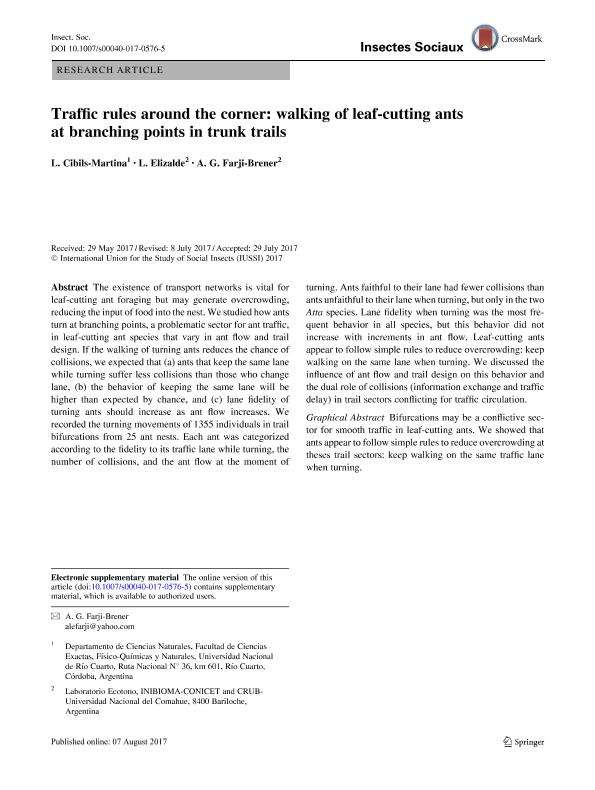Mostrar el registro sencillo del ítem
dc.contributor.author
Cibils Martina, Luciana

dc.contributor.author
Elizalde, Luciana

dc.contributor.author
Farji Brener, Alejandro Gustavo

dc.date.available
2019-05-14T17:56:04Z
dc.date.issued
2017-11
dc.identifier.citation
Cibils Martina, Luciana; Elizalde, Luciana; Farji Brener, Alejandro Gustavo; Traffic rules around the corner: walking of leaf-cutting ants at branching points in trunk trails; Birkhauser Verlag Ag; Insectes Sociaux; 64; 4; 11-2017; 549-555
dc.identifier.issn
0020-1812
dc.identifier.uri
http://hdl.handle.net/11336/76271
dc.description.abstract
The existence of transport networks is vital for leaf-cutting ant foraging but may generate overcrowding, reducing the input of food into the nest. We studied how ants turn at branching points, a problematic sector for ant traffic, in leaf-cutting ant species that vary in ant flow and trail design. If the walking of turning ants reduces the chance of collisions, we expected that (a) ants that keep the same lane while turning suffer less collisions than those who change lane, (b) the behavior of keeping the same lane will be higher than expected by chance, and (c) lane fidelity of turning ants should increase as ant flow increases. We recorded the turning movements of 1355 individuals in trail bifurcations from 25 ant nests. Each ant was categorized according to the fidelity to its traffic lane while turning, the number of collisions, and the ant flow at the moment of turning. Ants faithful to their lane had fewer collisions than ants unfaithful to their lane when turning, but only in the two Atta species. Lane fidelity when turning was the most frequent behavior in all species, but this behavior did not increase with increments in ant flow. Leaf-cutting ants appear to follow simple rules to reduce overcrowding: keep walking on the same lane when turning. We discussed the influence of ant flow and trail design on this behavior and the dual role of collisions (information exchange and traffic delay) in trail sectors conflicting for traffic circulation. Graphical Abstract: Bifurcations may be a conflictive sector for smooth traffic in leaf-cutting ants. We showed that ants appear to follow simple rules to reduce overcrowding at theses trail sectors: keep walking on the same traffic lane when turning.
dc.format
application/pdf
dc.language.iso
eng
dc.publisher
Birkhauser Verlag Ag

dc.rights
info:eu-repo/semantics/openAccess
dc.rights.uri
https://creativecommons.org/licenses/by-nc-sa/2.5/ar/
dc.subject
Acromyrmex
dc.subject
Ant Behavior
dc.subject
Atta
dc.subject
Foraging Trails
dc.subject
Locomotion
dc.subject
Transport Networks
dc.subject.classification
Otras Ciencias Biológicas

dc.subject.classification
Ciencias Biológicas

dc.subject.classification
CIENCIAS NATURALES Y EXACTAS

dc.title
Traffic rules around the corner: walking of leaf-cutting ants at branching points in trunk trails
dc.type
info:eu-repo/semantics/article
dc.type
info:ar-repo/semantics/artículo
dc.type
info:eu-repo/semantics/publishedVersion
dc.date.updated
2019-04-15T18:25:00Z
dc.identifier.eissn
1420-9098
dc.journal.volume
64
dc.journal.number
4
dc.journal.pagination
549-555
dc.journal.pais
Suiza

dc.journal.ciudad
Basel
dc.description.fil
Fil: Cibils Martina, Luciana. Universidad Nacional de Río Cuarto. Facultad de Ciencias Exactas, Fisicoquímicas y Naturales. Departamento de Ciencias Naturales; Argentina. Consejo Nacional de Investigaciones Científicas y Técnicas. Centro Científico Tecnológico Conicet - Córdoba; Argentina
dc.description.fil
Fil: Elizalde, Luciana. Consejo Nacional de Investigaciones Científicas y Técnicas. Centro Científico Tecnológico Conicet - Patagonia Norte. Instituto de Investigaciones en Biodiversidad y Medioambiente. Universidad Nacional del Comahue. Centro Regional Universidad Bariloche. Instituto de Investigaciones en Biodiversidad y Medioambiente; Argentina
dc.description.fil
Fil: Farji Brener, Alejandro Gustavo. Consejo Nacional de Investigaciones Científicas y Técnicas. Centro Científico Tecnológico Conicet - Patagonia Norte. Instituto de Investigaciones en Biodiversidad y Medioambiente. Universidad Nacional del Comahue. Centro Regional Universidad Bariloche. Instituto de Investigaciones en Biodiversidad y Medioambiente; Argentina
dc.journal.title
Insectes Sociaux

dc.relation.alternativeid
info:eu-repo/semantics/altIdentifier/url/http://link.springer.com/10.1007/s00040-017-0576-5
dc.relation.alternativeid
info:eu-repo/semantics/altIdentifier/doi/http://dx.doi.org/10.1007/s00040-017-0576-5
Archivos asociados
